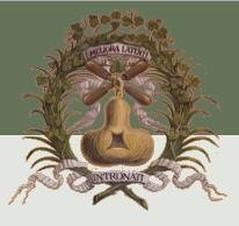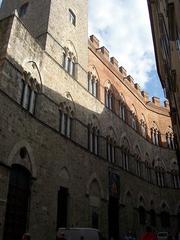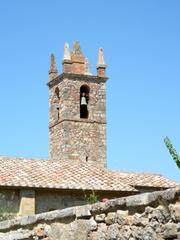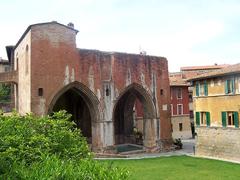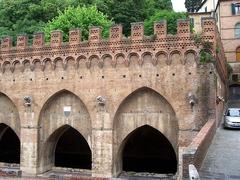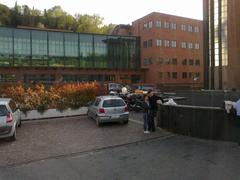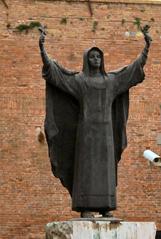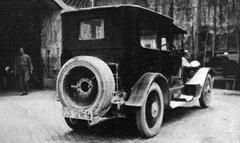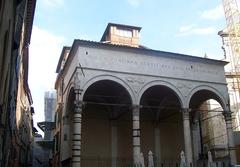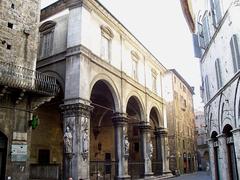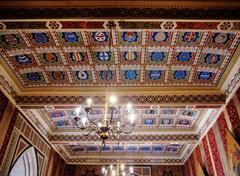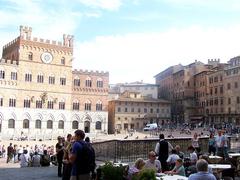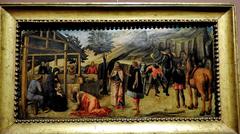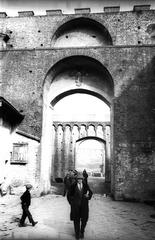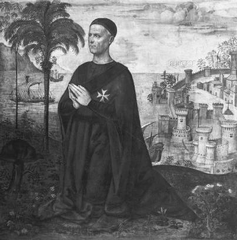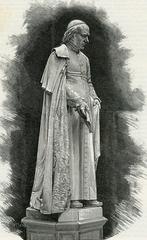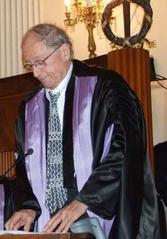Santa Maria di Provenzano Visiting Hours, Tickets, and Siena Historical Sites Guide
Date: 15/06/2025
Introduction
Santa Maria di Provenzano is a jewel in the heart of Siena, Italy—an architectural and spiritual landmark revered for its miraculous Madonna icon, deep ties to the Palio di Siena, and richly adorned Baroque interiors. As both an active parish and a pivotal site in the city’s cultural history, the church offers a unique, contemplative experience distinct from Siena’s busier attractions. This detailed guide provides historical context, highlights of the church’s art and architecture, practical visitor information, and travel tips to enrich your exploration of Siena’s historical core.
For additional planning resources, refer to the official church page, Collegiata Provenzano, and the official Siena tourism site.
Table of Contents
- Origins and Historical Development
- Architecture and Artistic Heritage
- The Miraculous Icon of the Madonna di Provenzano
- The Church and the Palio di Siena
- Visiting Information: Hours, Tickets, and Accessibility
- What to See Inside
- Practical Tips and Nearby Attractions
- FAQ
- Conclusion and Resources
Origins and Historical Development
Santa Maria di Provenzano’s origins are tightly woven into Siena’s identity. The church emerged in the Provenzano district in the late 16th century, inspired by the miraculous reputation of a terracotta Madonna icon, venerated since the 1500s. According to local tradition, the icon’s legend began during the 1552 siege, when a Spanish soldier’s musket shot at the Madonna image resulted in his own injury—a sign interpreted as the Virgin’s protection over Siena (BEWEB). This miracle catalyzed the construction of a new sanctuary.
Construction of the present church began in 1595 under architect Flaminio Del Turco, with completion in 1611. It was designed to enshrine the Madonna icon and to serve as a testament to Sienese resilience following the city’s political decline in the wake of the Republic’s fall. The church has since remained a spiritual and civic anchor for Siena, witnessing significant historical events and embodying the city’s enduring faith (Collegiata Provenzano).
Architecture and Artistic Heritage
Santa Maria di Provenzano is a striking example of late Renaissance and early Baroque architecture in Tuscany. Its Greek cross plan, majestic dome, and refined façade showcase the transition from Mannerism to Baroque, a movement emphasizing both classical order and expressive ornamentation.
Exterior Features
- Façade: Built from local travertine, the façade features two levels divided by a cornice and crowned by a triangular tympanum, with Baroque details accentuating the entrance.
- Dome: The central dome, visible throughout the city, was designed with input from Don Giovanni de’ Medici, reflecting advanced engineering and harmonious proportions.
Interior Design
- Plan: The church follows a Latin cross plan with a single nave, side chapels, and a transept that emphasizes processional movement.
- Natural Light: Windows in the dome and walls flood the interior with light, enhancing the marble and gilded decorations.
- Polychrome Marble Floor: Under the dome, the floor features elaborate inlays of colored marble, including the Medici and Sienese coats of arms, symbolizing both civic pride and religious devotion.
Artistic Masterpieces
- High Altar: Designed by Flaminio Del Turco, the altar frames the Madonna di Provenzano icon with silver angels and flanking statues of Saints Catherine and Bernardino by Giovanni Battista Querci.
- Paintings: Works by Francesco Vanni and Rutilio Manetti, among others, depict Marian scenes, the Palio, and local saints.
- Gilded Angels: Four gilded wooden angels, attributed to Domenico Arrighetti, illuminate the transept with a celebratory atmosphere.
Historical relics include a flag captured from the Turks at the 1683 Battle of Vienna and another from the Medici Fortress, representing Siena’s transition from military stronghold to civic sanctuary.
The Miraculous Icon of the Madonna di Provenzano
At the heart of the church is the revered terracotta Madonna di Provenzano, a 14th- or early 15th-century icon central to Sienese devotion. Associated with miracles during siege and plague, the Madonna became a symbol of hope and communal identity, especially after the Republic’s fall. Its significance was further affirmed by a papal coronation decree in 1681, cementing the church’s status as a pilgrimage site (Collegiata Provenzano, Palazzetto Rosso).
The Church and the Palio di Siena
Santa Maria di Provenzano is inseparable from the Palio di Siena, the city’s legendary July 2nd horse race. The Palio banner (drappellone) is blessed at the church before the race, and the winning contrada returns in thanksgiving procession. The Palio’s rituals, songs, and processions underscore the fusion of religious devotion and civic tradition that defines Siena (visitsienaofficial.it).
Visiting Information: Hours, Tickets, and Accessibility
- Opening Hours: Generally open daily from 9:00 AM to 6:00 PM; Sunday hours may be shorter (10:00 AM to 1:00 PM). Hours can vary during religious events and the Palio. Always confirm in advance (collegiataprovenzano.siena.it).
- Tickets: Admission is free for individual visitors; donations are welcome. Special concerts or events may require tickets.
- Accessibility: The church is mostly accessible, with ramps at the entrance. Surrounding cobbled streets may present challenges; contact the church in advance for specific needs.
- Guided Tours: Available through the church and local tour operators. Tours often include in-depth discussion of art, history, and the connection to the Palio.
What to See Inside
- The Madonna di Provenzano icon: Central altar, surrounded by a glory of silver angels and votive offerings.
- Dome and marble floor: Intricate heraldic designs and natural lighting.
- Artworks: Paintings by Manetti, Vanni, and Mori; gilded angels; historic flags and relics.
- Oratory del Suffragio: Former crypt, now chapel for the Contrada of Giraffa, accessible from Via della Vergine.
Music lovers may find concerts scheduled in summer, taking advantage of the church’s acoustics and intimate atmosphere.
Practical Tips and Nearby Attractions
- Combine your visit: Santa Maria di Provenzano is a short walk from Piazza del Campo, Siena Cathedral, Palazzo Pubblico, and the Basilica of San Francesco.
- Dress code: Modest attire required; shoulders and knees covered.
- Photography: Permitted unless otherwise indicated, especially during services.
- Refreshments: Numerous trattorias and cafes nearby offer reasonably priced local cuisine (wanderboat.ai).
- Palio period: Expect larger crowds and restricted access; arrive early for events.
FAQ
Q: Are tickets required to enter Santa Maria di Provenzano?
A: No, entry is free except during special events or concerts.
Q: What are the opening hours?
A: Typically 9:00 AM–6:00 PM daily; check official sources for current times.
Q: Is the church accessible for mobility-impaired visitors?
A: The main entrance is equipped with ramps, but nearby streets are cobbled. Contact the church about specific needs.
Q: Are guided tours available?
A: Yes, through local operators and the church.
Q: Can I take photos inside?
A: Generally, yes—except during services or where posted.
Conclusion
Santa Maria di Provenzano epitomizes Siena’s rich blend of spiritual devotion, artistic achievement, and living tradition. Whether you’re captivated by its miraculous icon, architectural marvels, or its role in the Palio, the church provides a serene and meaningful experience in the city’s historic core. To maximize your visit, check opening hours, consider joining a guided tour, and explore nearby landmarks for a full immersion in Siena’s heritage.
For real-time updates, audio guides, and travel tips, download the Audiala app and follow local tourism channels. For detailed planning, always consult the official church website and Siena’s tourism portal.
Additional Resources
- Chiesa di Santa Maria in Provenzano | Siena (SI)
- Collegiata Provenzano
- Visit Siena Official
- Wanderboat AI
- Palazzetto Rosso
